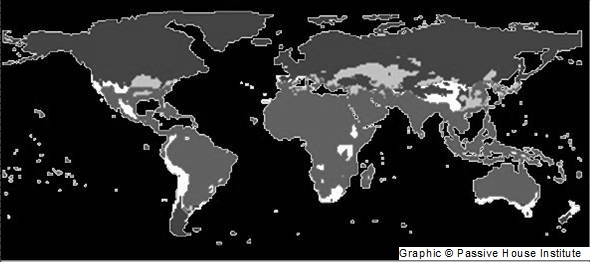Table of Contents
Passive House in warm climates - Introduction
Various questions have to be posed when looking at Passive Houses in warm climates. How can Passive Houses be built in warm climates such as the Mediterranean climate and what strategies are reasonable? What is the respective impact of different design parameters? What performance level of components is required for the building envelope and mechanical services? And what challenges does this pose on the component industry? First realized projects and various studies can already give some answers.
The Passive Houses discussed in this article are located in warm, but not hot, and mainly dry regions, with annual mean temperatures between 15 and 23°C and no dehumidification demand all year round. The highest monthly mean dew point temperature is 16°C (Volos, Greece). This comprises climates that are warmer than the central European climate, such as most regions in Spain and Italy. Included, but a somewhat special case are so-called “happy” or “easy” climates. These are zones where the situation all year round is so mild and advantageous that comfortable indoor conditions can be easily achieved, without or with very little energy demand. Examples are the area around the city Guadalajara, Mexico, as well as most parts of Portugal, see Figure 1.
 |
| Figure 1: White: Regions with warm, moderate climate (depending on altitude), where it is relatively easy to achieve Passive House (“Happy climates”). Source: Passive House Institute |
Warm and humid climates, like the climate of Seoul, South Korea, which is warm but also has two humid months, as well as more extreme climates such as the hot climates of Las Vegas, US, Shanghai, China, and Tokyo, Japan, are not covered in this article. They are analysed in the studies [Schulz 2012] and [Feist 2012]. Certified Passive House examples in those regions can be found in the Passive House Database.
Read more
Conclusion
First certified Passive Houses in warm climates show the optimisation potential in design and execution. While lower levels of insulation are sufficient for moderate and warm climates such as the majority of the Mediterranean region, high levels of insulation in opaque elements of the building envelope are required for extremely hot climates.
To achieve cost-efficient solutions, the resulting insulation thicknesses call for optimised compactness of the building shape. Windows should meet the comfort and energy requirements, and the designer should be aware of the high influence of the best orientation.
Very good airtightness is important in all climates, and especially for hot and humid climates [Schnieders et. al. 2012]. Active cooling could be avoided in so-called ‘Happy climates’, but is mandatory for very warm climates (for instance Granada, Spain).
Ventilation strategies include natural ventilation in summer as well as mechanical ventilation (extract air system only or ventilation system with heat exchanger and summer bypass). For cost effective Passive Houses in warm climates component performance should be in the focus of all stakeholders.
Acknowledgements
The presentation is based on realised Certified Passive Houses and studies on Passive Houses for different climate zones by the Passive House Institute. Thanks to GIZ, DBU, Saint-Gobain as well as all involved Passive House designers and architects for their support.
See also
Start page - Passive House buildings in different climates
Read more about the studies Passive Houses for different climate zones and Passive Houses in tropical climates
Overview - Passive Houses in warm climates
